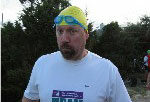In October of 1993, when I was 47, my left leg started swelling from my hip to my toes and I started experiencing trouble breathing. My leg felt so tight, that I couldn’t bend my knee, so I contacted an orthopedic practice who then referred me to an internal medicine physician, Dr. D. Dr. D. gave me a Doppler test which showed that I had numerous blood clots in my left leg; five from knee to ankle and five from knee to hip. The diagnosis was severe deep vein thrombosis (DVT). I was, frankly, frightened as he told me about this, especially since he thought a clot might have gone into my lung, which would explain why I was having trouble breathing.
I was admitted to the hospital, where I stayed seven days on a heparin drip to stop the blood clots. I was told that my leg might need to be amputated, one day, due to the severity of the condition. I was released from the hospital, but it turned out that the treatment did not work, because I immediately started having problems. The next day, when I was at home, I became very sick. My leg became swollen and turned almost black, especially around my foot. I went back into the hospital and they immediately put an IV in the big toe of my left foot and I was given a drug called Streptokinase, which breaks up blood clots. I was given this clot busting drug for five days.
The Streptokinase was extremely costly, one vial was about $3,000, resulting in a total hospital bill of $102,000. Worse than the cost was the fact that this treatment failed, as well. At this point, Dr. D. recommended that I use a sequential compression pump. This machine is used with a sleeve that wraps around the leg, and forces the blood to circulate through the leg. I started using this equipment right away. After using the pump, I have to put lotion on my skin to keep it from drying out. In addition to the pump, Dr. D. prescribed one baby aspirin and Coumadin, taken daily.
I was instructed to wear a compression stocking all day and to sleep with my leg elevated. I was told to exercise by walking and doing water aerobics five times a week. Once a month, I have a blood test to check that the Coumadin has made my blood thin enough so that I don’t get new clots. Adhering to this treatment really helped to keep the swelling down in my leg. I was feeling much better.
Over the next few years, using the pump became a way of life for me. I was determined that my medical problems wouldn’t stop me from traveling and doing what I wanted to do. For example, in 1998, I took a 12 day trip to England, Paris, Sweden, and Rome. There, in my luggage, was my faithful pump along with an international electrical converter. But, to my dismay, the converter was not compatible with the pump and the pump burned up the first day in England! So, without the use of the machine, I managed by laying flat on the floor for about an hour each night, with my legs and feet up against the wall, so that I could “milk” the swelling out with my hands. I slept with my feet elevated, continued wearing the compression hose, and had a great vacation.
When I returned back home, I got a new pump. For all these years, I had no medical explanation for the blood clots. I still wanted to know what was causing them. So, in 1999, I decided to call the Hematology department at our state university. Dr. W. answered the phone and I told him about my condition. I had an appointment with him and he ordered blood work. The tests showed that I have a defective gene called factor V Leiden. He advised me to continue taking the Coumadin. My family was tested and my brother and daughter both tested positive for this condition.
In 2001, I had a few ulcers in my left leg. I saw Dr. D., and he told me that the valves in my legs had collapsed which resulted in no blood return from the legs, and that there was no cure for this. He prescribed an Unna boot, which was changed every 10 days. This device is like a soft cast from ankle to knee that delivers medicine to the leg. I had to have total bed rest for three months. To reduce swelling, I still
used the pump, which was put on over the boot at night.
In 2002, my right leg started to swell. I did not seek medical attention, but I began using the pump on this leg one hour a night, as well. Finally, in 2005, I made an appointment with a new doctor, Dr. S. He ordered an MRI, and it showed old
blood clots in my stomach and, most importantly, that there was a 90% blockage of the vena cava (the main vein in the
abdomen that drains both legs).
Dr. S. recommended surgery, although the risk was high. The surgery, vena cava stenting, would involve placing stents, which are tiny mesh tubes, in the veins to hold them open. There was only a 50% chance of success with the operation. The morning of the operation, the surgeon told us in the family conference, that the likelihood of success was only about 20%. As frightening as this news was, I still felt that 20% was better than nothing. My brother was there with me, and supported me in this decision. In the vena cava, one six inch stent was inserted and two more stents were placed in the same vein.
My left leg received two stents and my right leg had one stent inserted. Well, the operation was a success! The swelling went down about 30% in my left leg, and some color has come back. For the first time in 13 years, I am able to walk on a treadmill and am presently doing one mile and working up to two miles. I still use the pump and take the Coumadin and baby aspirin, along with exercising and wearing hose. Once, when I was in the hospital, I started feeling sorry for myself until I saw a man who was brain damaged and who was missing an arm and a leg. Since then, I have deliberately taught myself to not think about pain. I’ve always told myself that losing a leg is not the worst thing in the world. Even then, I would still be able to watch Carolina basketball, watch sunsets and sunrises, do my oil painting, and be with my family and the people that I love. I attribute the success of my health today to my faith in God, my doctors, and keeping a positive attitude.
Posted October 30, 2008



